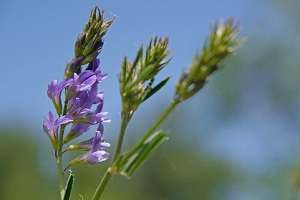Exotic legume improves livestock feeding

A Mediterranean legume has the potential to reduce local greenhouse gas emissions when fed to livestock.
UWA researcher and plant breeder William Erskine says in vitro trials shows digesting the plant Biserrula pelecinus produces almost ten times less methane than subterranean and red clovers (Trifolium subterraneum L. and Medicago sativa L.).
Associate Professor Erskine says it also appears to be more nutritious, as sheep rumen digests more fatty acids in Biserrula than these forage crops.
"Material that was being ingested was not used by the animal to grow, so it's a double loss, a loss in terms of productivity," he says.
Prof Erskine says the plant is unlikely ever to become a weed because of its symbiotic relationship with exotic Rhizobia bacteria.
"It's not a very promiscuous nodulater," he says.
"It doesn't go with the native Rhizobia, so when you are using it you've definitely got to inoculate to get Rhizobia to cover it."
They found no naturalised Biserrula in Australia.
The researchers ran in vitro anaerobic fermentation tests using rumen microbes on 30 greenhouse-grown Biserrula varieties from Spain, France, Italy, Greece, Israel, Eritrea and Morocco.
In a second experiment they planted one of the varieties at UWA's Ridgefield Farm in Pingelly and DAFWA's Esperance Downs Research Station in Gibson to confirm that the plant's low methanogenic potential is maintained in field conditions.
In each experiment, edible parts of the plants were prepared and fermented in freshly-collected sheep rumen, using an in vitro method commonly used to examine plant fermentability.
The team is planning further in vitro trials of Biserrula, in combination with other plants.
"What we've got to find out now is can you use it as a tool to reduce the amount of methane being produced when the animals are eating a bit of something else," he says.
Further research will also aim to identify the active chemical or chemicals that mitigate methane production.
The researchers may then investigate other plants, including native flora, to see if this active agent is present, or perhaps see if it can be cost-effectively synthesised.
The team plan to conduct in vivo management trials, probably on sheep, when the results are in.
This may include supplementing animal diet with prepared Biserrula feed, or rotating stock on to Biserrula plots for grazing.
Biserrula could play a substantial role in reducing Australia's greenhouse gas emissions.
The Garnault Report says methane emissions from rumen comprise about half of the methane produced by grazing animals.
Provided by Science Network WA


















